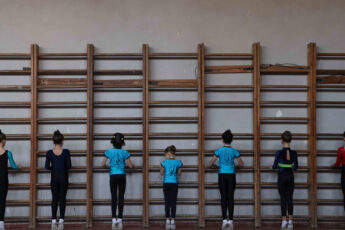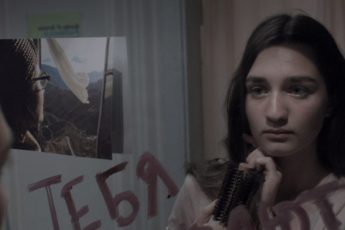Ilya and Emilia Kabakov Take Paris
Amei Wallach’s Ilya and Emilia Kabakov: Enter Here (2013)
Vol. 43 (July 2014) by Patricia Bass
You have to decide at a certain point what exactly do you want to be for your country and if it’s still your country…Do you want them to understand what you do, or do you just discard everything you did in your lifetime, as if it never existed?”
– Ilya Kabakov (citation from the film Enter Here)
Ilya and Emilia Kabakov’s recent installation at the Grand Palais, “L’étrange cité (Strange City)”, and the 2013 documentary on the couples’ work show a struggle with questions of national, generational, and even ideological belonging.
As Ilya’s statement implies, the relationship of an exiled artist with his or her country is ambiguous. Ilya Kabakov, born in 1933 in Soviet Ukraine, fled the USSR in 1987. Within the next two years he had exhibited his work in New York, Bern, Venice, and Paris. In 1992, he settled down in Long Island with his wife and creative partner, Emilia Kabakov, where they have lived since.
The documentary Ilya and Emilia Kabakov: Enter Here shows how this Western success story is also a story of loss and negotiation with Ilya’s Soviet past. Ilya’s experience under Stalin is ambiguous: a touching reading of his mother’s diary reveals that she was “bureaucratically homeless” – denied a residential permit (propiska) by the Soviet government, she spent years of her adult life sleeping in public bathrooms, outside, and at the houses of those who dared to take her in. Emilia describes her husband’s experience with communism as more traumatic and paranoia-inducing than her own due to the fact that he was born twelve years earlier. Yet at the same time, Ilya describes Stalin as merely a tertiary character in his life – less on his mind than the school-yard bully, as he put it. Later, under Khrutschev, Ilya benefited from a coveted “national artist” status. This allowed him access to the lucratively-paid job of children’s book illustration; he would illustrate for three months during the summer, and live off of that income while he worked on his own projects for the rest of the year.
This ambiguity comes alive in the Kabakov’s “total installations” where spaces are constructed and objects carefully chosen to create a penetrable artwork. For example, to visit the installation “The Toilet” (1992), visitors would enter a small building (inside the museum or art gallery) where they would find a public restroom, complete with stalls, toilets and sinks. Yet the room was also filled with furniture, a bed, dresser, nightstand and table (set for dinner), as well as personal objects, like children’s toys, spread about as if a whole family lived there. The room evokes the difficult living conditions of those (like Ilya’s mother) outside the graces of the Soviet bureaucracy, and contrasts that with a certain nostalgia and familiarity.
In Enter Here, we see early stages of this exhibit’s construction. The painters in Kassel, Germany, where the work is being installed, have painted the exterior of the building too well. Ilya reminds them that this is Soviet work, it must be poorly done! He has them redo it – but this time, it was too shoddy. This interaction reveals the underlying tensions in the Kabakovs’ work: they represent a Soviet past that is sentimental, but full of suffering, for a Western audience who is far from even knowing what a “Soviet paint job” would be. The Kabakovs even feel distanced from their Russian audiences. During the documentary, Ilya and Emilia express their fears that the younger generations who never knew the communist regime of Stalin will not be able to relate to the memories that their work relates.
Perhaps to respond to these challenges, the Monumenta installation in Paris uses the Soviet system as an allegory for utopian concepts in general. The Kabakovs installed five lodges in the heart of the Grand Palais. In each, the visitor finds a circular hallway of drawings or paintings surrounding a large model of a utopian structure (ladder to reach one’s guardian angel, a mountain with an interior staircase as analogy for reaching heaven, etc.) built by a mythical ancient society.
The Kabakovs’ statement on utopia is rather tongue-in-cheek. For example, the lodge themed on angels includes paintings of angels (with aesthetics ranging from classical to comic strips) and directions. You can try to be a better person by limiting your sins, striving to do good, or following a given ideology. Otherwise, you can strap on home-made wings for one hour a day and soon feel a result.




Leave a Comment